
2.Multiple Dryer (Common) Venting
If it is not feasible to provide separate exhaust ducts for each dryer, ducts from individual dryers may be channeled into a common main duct. The individual ducts should enter the bottom or side of the main duct at an angle not more than 45° in the direction of the airflow.
IMPORTANT: No more than eight (8) dryers should be connected to one (1) main common duct.
NOTE: Refer to the illustration on the next page for examples of multiple dryer (common) venting.
The main duct may be any shape so long as the minimum
IMPORTANT: For extended ductwork runs, the
IMPORTANT: Exhaust back pressure measured by a manometer at the dryer’s exhaust duct area must be no less than 0 and must not exceed 0.3 inches of water column (W.C.) when both baskets (tumblers) are operating.
The ductwork should be smooth inside with no projections from sheet metal screws or other obstructions, which will collect lint. When adding ducts, the duct to be added should overlap the duct to which it is to be connected. ALL ductwork joints must be taped to prevent moisture and lint from escaping into the building. Also, inspection doors should be installed at strategic points in the exhaust ductwork for periodic inspection and cleaning.
NOTE: When the exhaust ductwork passes through a wall, ceiling, or roof made of combustible materials, the opening must be
To protect the outside end of the horizontal ductwork from the weather, a 90° elbow bent downward should be installed where the exhaust exits the building. If the exhaust ductwork travels vertically up through the roof, it should be protected from the weather by using a 180° turn to point the opening downward. In either case, allow at least twice the diameter of the duct between the duct opening and nearest obstruction.
14 | Maytag Co. | 113062 - 16 |
